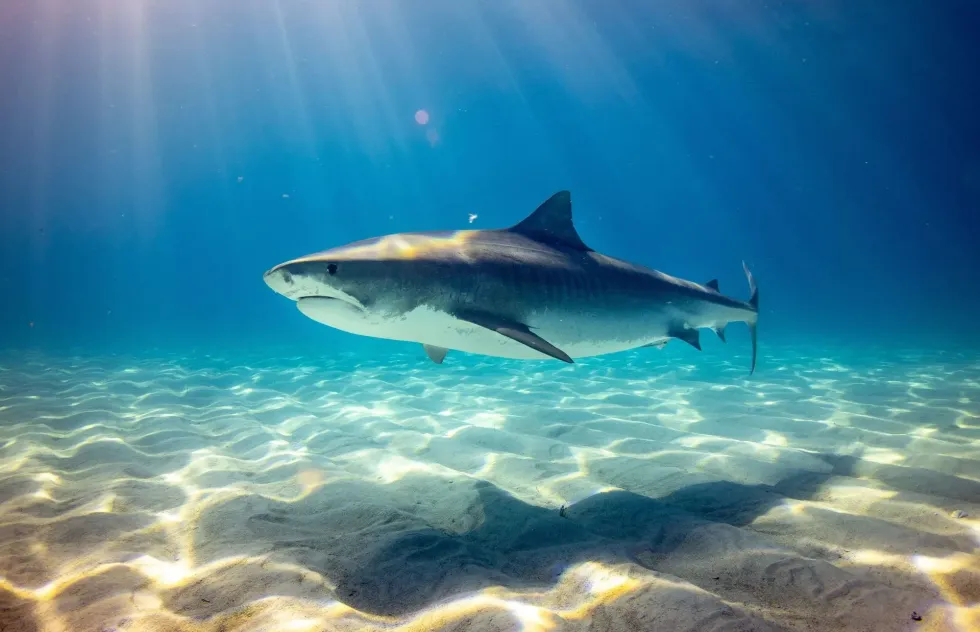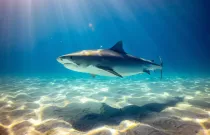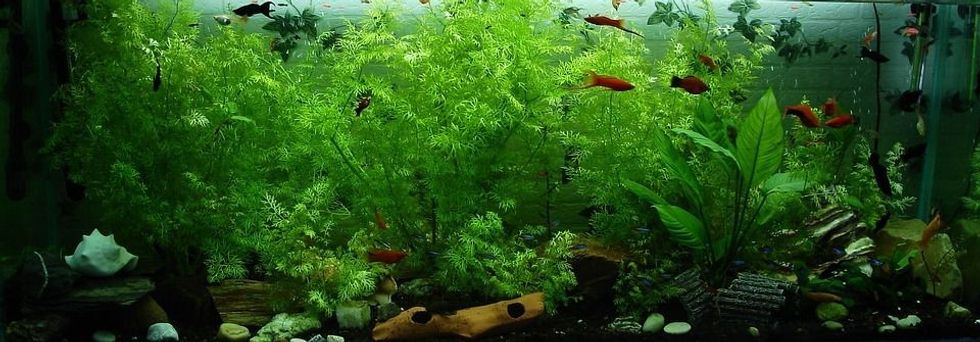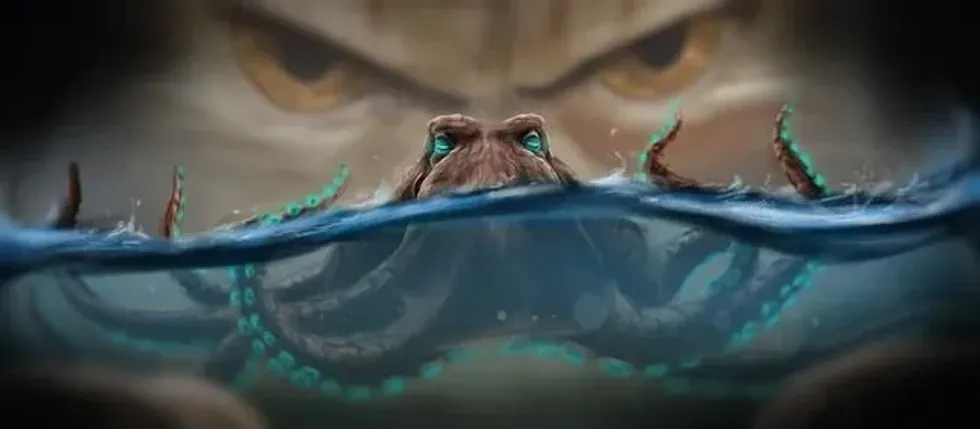Red Tail Shark Size Facts! See If They Are Aquarium Friendly

The red tail shark is a freshwater fish that belongs to Thailand.
The red tail shark is known to be a very active fish. The majority of the body of the red tail shark is black, with the fin being red in color.
Other names of red tail sharks are red tail shark minnow, red tail black shark, and fire tail shark. It is a small fish that is considered to be fierce.
The red tail shark, a freshwater fish, is known to be endangered. The red tail shark was even considered to be extinct in 2011, but today these freshwater fish are seen in aquariums all around the world.
Because of their size, red tail sharks can be used in a variety of medium to big aquariums. The red tail shark is a colorful tropical fish. It is one of the tiniest freshwater sharks on the planet. Red tail sharks do not, however, behave as if they are small and are known to be active fish.
To know more about the behavior of a red tail shark and if a red tail shark is suitable for the aquarium, keep reading the article! Afterward, also read about the rainbow shark size and how sharks give birth.
Red Tail Shark Lifespan
The red tail shark is an active fish. The red tail shark is an interesting fish to watch and can keep you entertained for hours. The red tail shark (Epalzeorhynchos bicolor) is a small freshwater fish native to Thailand.
Red tail sharks are very easy to feed because of their non-fussy demeanor. Once red tail sharks are settled into their tank, they do not pose too many problems for keeping them content.
The life expectancy of a red tail shark is between five to eight years. Although there can be a chance that your red tail shark can get ill early, there are a few things you can do to help a red tail shark live a long and healthy life.
There are some things you can do toincrease the lifespan of your red tail shark, like buying your red tail shark from a reliable seller, providing red tails a habitat that looks similar to its natural habitat and proper aquarium settings, and lowering stress by keeping them with the right tank mates.
When fully mature, the average red tail shark size is between 4-6 in (10.16-15.24 cm) long. This is presumptively based on proper care and genetic conditions.
The red tail shark has a rather basic appearance. Red tail sharks come in only black and red color, and the body of red tail sharks has a characteristic feature that makes them look like a shark. It's the fiery fin of a red tail shark that is its most attractive feature.
The hue changes from a black body to a bright red tail exactly at the end of the caudal peduncle. A vertical line passes through the dorsal fin, where the color suddenly changes.
It is because of its dorsal fin, which resembles that of a shark, that the red tail shark gets its name.
The body of a red tailed shark is long and slender, with a curved back and flat sides. You'll note that the head of a red tail shark has red color eyes and a mouth with two pairs of barbs that look like hooks.
The red tail shark has a mouth suited to eat algae from the bottom of the aquarium.
Red tail sharks do not have any other color variants. Rainbow sharks are frequently confused with red tail sharks. It's critical to distinguish between two fish because red tail fish and rainbow fish are not compatible tank mates and will fight if kept in the same aquarium.
So, what makes a red tail shark different from a rainbow shark? Mentioned below are some of the differences.
Red tail sharks: The tail is the only part of the red tail shark that is red in color. The rest of the body of red tail sharks is a deep velvet black, with no visible markings.
Red tail sharks occupy the water column's bottom and center. A red tail will only come to the surface to feed and it prefers faster water flow. In the natural environment, red tail sharks live in fast-moving streams and rivers.
Rainbow sharks: Fins are crimson-colored in rainbow sharks and their bodies are silver-black but an albino variation has been observed as well. Rainbow sharks are known as algae eaters and as being bottom feeders; they will remove algae from plants and rocks faster than their red tail competitors.
For this species, the closer to the bottom, the better it is. They will spend a lot more time on the substrate than red tail sharks.
How do you pick a tank mate for a red tail shark?
You'll notice that your red tails are somewhat shy when they are young. As a result, you should provide red tail sharks with plenty of hiding places in the aquarium. When red tail sharks reach adulthood, they tend to have aggressive tendencies and may become hostile toward tank mates that may be in the same aquarium.
Since red tail sharks have the ability to become violent, it's essential that you choose the correct tank mates for them.
Red tail sharks aren't suitable tank mates for fishes that are inquisitive, hostile or love to dwell at the bottom.
Either these fish will venture into the red tail shark's area, or they'll start a battle.
Compatible tankmates are those that keep to themselves and spend more time in the upper half of the tank. There is no certainty that you won't see any aggressive behavior from red tail sharks against tank mates, so if you want to maintain them in a community tank, make sure you get suitable tank mates only.
Some recommendations for red tail shark tank mates are the Bala shark, the Congo tetra, the angelfish, the neon tetra, the honey gourami, the dwarf gourami, and the pearl gourami.
While keeping more than one red tail shark in the same tank as tank mates is not uncommon, it is not without risk. Because of the territorial nature of the red tail shark, these freshwater sharks are likely to fight with their tank mates unless they have a substantial amount of space.
A fish that looks similar to a red tail shark should not be placed in the same aquarium. The rainbow shark is an excellent illustration of such cases. The red color somehow encourages possessive and violent tendencies.
Instead of two red tail sharks, it's best to have a bunch of them in the same tank. However, this will mean purchasing a very large tank. This is why you can choose other fish as tank mates for a red tail shark.
While red tail sharks will not physically attack, eat or harass other fish, these red tail sharks will pursue them until they are exhausted. Red tail sharks can be found swimming back and forth in the bottom of the aquarium on a daily basis.
If you feed these small fish too close together during feeding time, you'll see this redtail shark pestering other fishes.
Aquarium conditions: The preferred red tail shark aquarium size is one that holds around 55 gal (250.03 L) of water. Although this freshwater shark isn't particularly large, red tail sharks are quite active and require a lot of space in the aquarium to swim.
The mentioned amount of water is also important for decreasing aggressive tendencies. Red tail sharks can have a territorial nature, which is exacerbated when they're directly next to each other.
You won't have to bother about water parameters when it comes to red tail shark care. This small fish is fairly resilient, and these red tail sharks prefer a wide range of temperatures.
The ideal water temperature range is 71-81 F (21.66-27.22 C). The pH level of the water should be between six to seven and the hardness of the water should be in the range of 12-16 KH.
Though red tail sharks are not delicate, the water condition of the aquarium should be checked every other day. This will keep all the essential parameters within the desired range and ensure better living conditions for your fish's health.
The red tail shark belongs to central Thailand and to the largest lake and swamp area where there is a lot of greenery, wood, and pebbles in these waterbodies. To make your red tail shark happy, you must invest in these items for the aquarium.
These items will not only enhance aquariums but will provide a familiar environment for these red tail sharks, which will help lessen their aggressive tendencies.
Red tail sharks prefer medium-sized gravel or pebbles as a substrate as they are mostly bottom-dwellers. Thus, choosing the correct habitat is crucial.
Plants like hornwort or water wisteria, which are both hardy and small, will work nicely for red tail sharks. Many owners have stated that their red tail sharks prefer to live amongst plants rather than in underwater caves.
Where are red tail sharks found?
The red tail shark was discovered in the pristine water bodies and floodplains of the MeNam Chao Playa basin, but the red tail shark was considered to be extinct because of widespread hunting.
Thailand is the only place on the planet where red tail sharks may be found. A specimen was caught in the Silom Canal on a 1934 trip.
The red tail shark is only known from a single location in the Chao Phraya basin, and the IUCN Red List classifies the red tail shark as Critically Endangered.
The red tailed black shark was thought to be nearly extinct from 1996 until 2011. There is no proof that collection for the aquaculture industry is to blame for the extinction of the red tailed black shark species; rather the dam and swamp draining that occurred throughout the '70s are more inclined to be blamed.
The other names of red tail sharks are the red tail shark minnow and the red tailed black shark. The red tail shark is a freshwater fish belonging to the Cyprinidae family of carps.
The red tail shark is unique to Thailand and is listed as Endangered, although it's popular amongst aquarium owners who appreciate its deep black body and bright red tail.
Today, red tailed black sharks are all bred in captivity and seen in the aquarium. Red tail sharks may be named after sharks, but they have no features that resemble those of sharks.
Although there is no concrete evidence if the aquarium industry is at fault for the population decline, it is important that people handle this species with additional care. This can be done by purchasing one red tail shark if you're very certain you'll be able to give the fish enough space and good living conditions.
While this should be your mindset with every fish you keep, for an endangered species like the red tail shark, you should be absolutely sure.
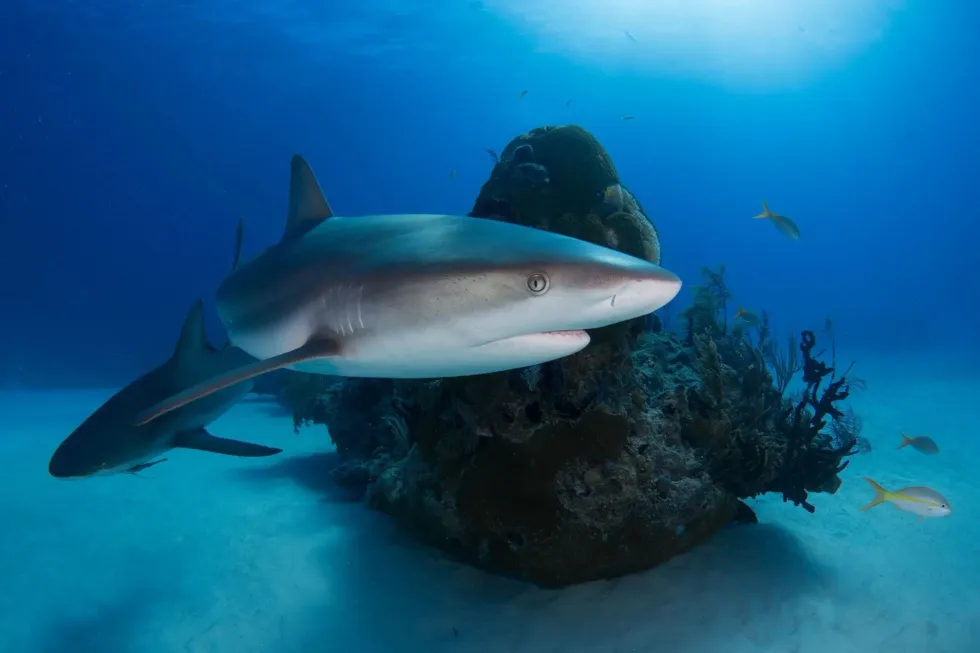
Can you put red tail sharks in an aquarium?
While red tail sharks are interesting and beautiful fish, there are a number of obstacles for new fish keepers. The most notable challenge is the territorial behavior of this freshwater shark and the need for a big tank.
If you have the capacity and resources for a large aquarium, you can prevent many territorial behavioral patterns by providing plenty of hiding spots for your red tail shark.
If you can supply red tails sharks with an appropriate aquarium, these freshwater sharks will be an excellent addition to your tank, adding rich, brilliant colors to it.
When it comes to the diet of red tail sharks, these red tails are omnivores, meaning your freshwater shark will not mind what it eats! Red tail sharks eat plants, insects, and crustaceans in their natural habitat. Obviously, it's difficult to recreate a red tail shark's natural diet in captivity, but it's not impossible.
As a primary source of nutrition, most owners feed red tail sharks flakes or pellets. There's nothing fancy about this; simply choose your favorite high-quality fish food.
You can also include some fun activity items for your red tail shark to add some variety. This will not only make your red tail shark happier but will also help it live longer.
Some recommended choices by experts include brine shrimp, blood worms, and tubifex. These are not only high in protein and nutrition, but they also encourage your freshwater shark to engage in a variety of energetic activities.
Various aquarists suggest including some veggies, such as zucchini or cucumber, for variety. Ensure portions are tiny enough to be readily consumed because red tail sharks are not fussy about the food they consume.
It's essential that you don't overfeed them. You're probably feeding them too much food if they can't finish what you fed them in a few minutes.
Red tail sharks are also called algae eaters, and you'll notice them scraping algae off of your tank's stones.
Red tail sharks do not have a specific disease that affects them, but they are susceptible to any of the usual freshwater diseases. Ich and fin rot are the most prevalent.
The chances of this occurring are reduced substantially if you offer them excellent care and high-quality water, but it is still always a risk. You should also inspect your fish every day for several minutes.
Take a good look over their body to see if you can spot anything unusual or something different in their behavior. The sooner you notice the problem, the better.
There are various signs you can look for before buying the fish from a fish store. The colors must be nice. The fish must have good swimming ability. The fish must not be gagging or gasping.
Fins and body must be in good shape. No bones should be visible. Two further positive symptoms to watch for are bright, clean eyes and no apparent parasites visible to the naked eye.
There are some symptoms of stress or illness which you must look out for such as pale tones, yellowing, breathing problems, fins that have become torn, the body condition looking underfed, and swimming looking forced.
Also, look at the condition of the tank the shop owner has kept the red tail black shark in and ask some questions to yourself before purchasing. Are any of the fish in the tank dead?
Is there any cloudiness in the water? Do any of the fish appear to be sick? If the answer to any of these questions is yes, you should avoid purchasing fish from that place.
The red tail shark is an incredibly beautiful freshwater fish that will thrive in your aquarium for a long time. The distinct appearance of red tail sharks and simple maintenance requirements make them suitable for people of all skill levels.
The only semi-complicated aspect is managing their aggressiveness, which is only a concern if you intend to maintain them in a community tank.
Here at Kidadl, we have carefully created lots of interesting family-friendly facts for everyone to enjoy! If you liked our suggestions for red tail shark size facts then take a look at great white shark bite force or do sharks make noise.
We Want Your Photos!
More for You
See All
Doctorate specializing in Veterinary Medicine

Oluniyi AkandeDoctorate specializing in Veterinary Medicine
With an accomplished background as a Veterinarian, SEO content writer, and public speaker, Oluniyi brings a wealth of skills and experience to his work. Holding a Doctor of Veterinary Medicine degree from the University of Ibadan, he provides exceptional consulting services to pet owners, animal farms, and agricultural establishments. Oluniyi's impressive writing career spans over five years, during which he has produced over 5000 high-quality short- and long-form pieces of content. His versatility shines through as he tackles a diverse array of topics, including pets, real estate, sports, games, technology, landscaping, healthcare, cosmetics, personal loans, debt management, construction, and agriculture.
Disclaimer
1) Kidadl is independent and to make our service free to you the reader we are supported by advertising. We hope you love our recommendations for products and services! What we suggest is selected independently by the Kidadl team. If you purchase using the Buy Now button we may earn a small commission. This does not influence our choices. Prices are correct and items are available at the time the article was published but we cannot guarantee that on the time of reading. Please note that Kidadl is a participant in the Amazon Services LLC Associates Program, an affiliate advertising program designed to provide a means for sites to earn advertising fees by advertising and linking to Amazon. We also link to other websites, but are not responsible for their content.
2) At Kidadl, we strive to recommend the very best activities and events. We will always aim to give you accurate information at the date of publication - however, information does change, so it’s important you do your own research, double-check and make the decision that is right for your family. We recognise that not all activities and ideas are appropriate for all children and families or in all circumstances. Our recommended activities are based on age but these are a guide. We recommend that these ideas are used as inspiration, that ideas are undertaken with appropriate adult supervision, and that each adult uses their own discretion and knowledge of their children to consider the safety and suitability. Kidadl cannot accept liability for the execution of these ideas, and parental supervision is advised at all times, as safety is paramount. Anyone using the information provided by Kidadl does so at their own risk and we can not accept liability if things go wrong.
3) Because we are an educational resource, we have quotes and facts about a range of historical and modern figures. We do not endorse the actions of or rhetoric of all the people included in these collections, but we think they are important for growing minds to learn about under the guidance of parents or guardians.

